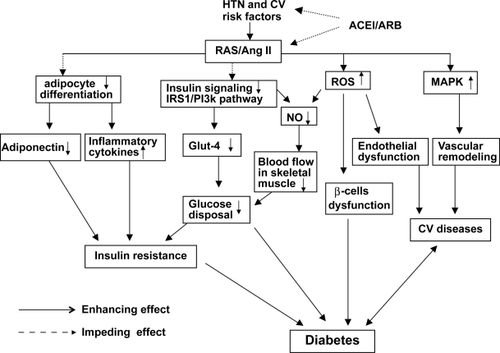Figures & data
Figure 1 Schemata of mechanisms underlying the prevention of diabetes development by inhibition of the renin–angiotensin system (RAS). Hypertension (HTN) and cardiovascular (CV) risk factors are commonly associated with activation of the RAS. Activation of angiotensin II produces the following biological effects: 1) inhibition of insulin activation of the phosphatidylinositol 3-kinase (PI3K) signaling pathway; 2) inhibition of pre-adipocyte differentiation into mature adipocytes, leading to reduction in secretion of adiponectin and increase in inflammatory cytokine production; 3) increased reactive oxygen species (ROS) production, resulting in islet structural damage and β-cell dysfunction; 4) activation of the mitogen-activated protein kinase (MAPK) pathway, leading to vascular remodeling and promotion of CV disease. All of these biological effects cause impairment of glucose metabolism and insulin resistance, thus contributing to the development of diabetes. Inhibition of RAS by either angiotensin converting enzyme inhibitors (ACEI) or angiotensin II type 1 receptor blockers (ARB) prevents these detrimental effects of angiotensin II on glucose metabolism and insulin resistance, therefore potentially reducing the development of diabetes and cardiovascular complications.
